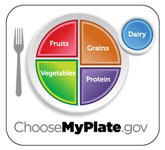

Establishing nutrition standards creates a foundation to provide objective criteria that can be implemented consistently. Very often, nutrition standards are incorporated into written policies at various levels. In July 2012, USDA released new nutrition standards that school districts across the nation implemented for the 2012-2013 school year. The changes outlined in Federal Register 7 CFR Parts 210 and 220 - Nutrition Standards in the National School Lunch and School Breakfast Programs; Final Rule came at a critical time in our society when nearly 1 in 3 children are considered at risk for preventable health conditions.
Together, First Lady Michelle Obama and Agriculture Secretary Tom Vilsack unveiled the much anticipated changes for school meals. In their effort to provide healthier meals for kids across the nation, Vilsack was quoted “Improving the quality of the school meals is a critical step in building a healthy future for our kids. When it comes to our children, we must do everything possible to provide them with the nutrition they need to be healthy, active and ready to face the future.”
The legislation focused on comprehensive changes to the school nutrition environment which had not been updated for over 15 years. The new nutrition standards for Child Nutrition Programs will aim to increase the availability of fruits and vegetables, whole grain bread products and fat-free and low-fat dairy products over the course of implementation. In addition, meals will provide lower amounts of saturated fat and sodium levels while eliminating trans fat from student meals.
Under the new legislation, the School Food Service (SFS) Department will continue to utilize Offer versus Serve (OVS). OVS allows students to decline some of the food items (components) offered in school breakfast or school lunch meals. The goal of OVS is to reduce food waste and permit students to select the foods they prefer as part of a complete meal. One major OVS change implemented during the 2012-2013 school year, was that students were required to select either a fruit or vegetable component as part of their reimbursable meal.
Below are the required components that must be offered to the students per meal, and what the students are required to select to create a complete reimbursable meal.
1. For breakfast, students must be offered 4 components: Protein, Grains, Fruit, and Milk. Students may select three or four of the above food groups to complete their meal. At least one of these choices must be from the fruit group.
2. For lunch, students must be offered 5 components: Protein, Grains, Fruit, Vegetable, and Milk. Students may select three, four, or five of the above food groups to complete their meal. At least one of these choices must be from the fruit or vegetable group.
Beginning in the 2012-2013 school year, fruits and vegetables were separated into different food groups or components and students had to select either a fruit or vegetable component to ensure a complete meal.
The school environment is one of several settings that can influence children’s food choices and eating habits. Therefore, meals should be designed to ensure that the foods offered meet or exceed the recommendations. In addition, staff should serve as role models for students by demonstrating healthy food and physical habits. The following were several key requirements set forth by the USDA to improve school lunch and breakfast beginning with the 2013 fiscal year:
- default_titleOffer a variety of fresh produce to include those prepared without added fats, sugars, refined sugars, and sodium
- default_titleOffer a variety of vegetables daily to include specific subgroups as defined by dark green, red/orange, legumes, and starchy
- default_titleOffer whole grain products – half of all grains need to be whole grain-rich upon initial implementation and all grains must be whole grain-rich two years post implementation
- default_titleOffer fluid milk that is fat-free (unflavored and flavored) and low-fat (unflavored)
- default_titleOffer meals that are designed to meet specific calorie ranges for age/grade groups
- default_titleEliminate trans fat from school meals
- default_titleRequire students to select a fruit or vegetable as part of a complete reimbursable meal
- Show More
USDA recognized the significance of these changes and provided an implementation timeline upon the release of the Final Ruling. The majority of the changes are expected to be implemented within the first five years, with the first year of implementation completed during the 2012-2013 school year.
The School Food Service (SFS) Department established a team of individuals to thoroughly review the Nutrition Standards in the National School Lunch and School Breakfast Programs; Final Rule. Collectively, this team determined the procedures in which to implement the required changes, and the strategies in which to communicate them.
Below is a list of strategies which the SFS Department utilized during the 2012-2013 school year to communicate the changes:
- default_titleHost mandatory trainings for all SFS employees to attend
>>>>>•• Training Agenda
>>>>>•• Training Tips to Consider When Implementing Offer vs. Serve
>>>>>•• Training for Offer vs. Serve - default_titleCreate marketing flyers
>>>>>•• Marketing Flyer for SFS Managers
>>>>>•• Marketing Flyer for Parents
>>>>>•• Marketing What Makes a Lunch Poster for Students
>>>>>•• Marketing Fruits and Vegetables on the Serving Line - default_titleSubmit an internal district bulletin for principals and assistant principals
>>>>>•• Changes to School Meals (USDA Required) P-14339-CAO/COO - default_titleIncorporate information into all menus (breakfast and lunch)
- Show More
To ensure compliance with the new regulations, five schools were selected for an on-site certification review. Through this process, all Palm Beach County schools were identified to be in compliance with the USDA regulations with the first year’s implementation of the nutrition standards. The SFS Department completed an attestation form at the completion of the review and all documentation was verified by the Food, Nutrition and Wellness Division of Florida Department of Agriculture.
Body Mass Index (BMI) is a standard that can be applied to most people in order to define obesity. BMI is calculated from a person’s weight and height and is often used to screen for weight categories that may lead to health problems.
Weight Categories based on BMI
BMI
Weight Status
Below 18.5
Underweight
18.5-24.9
Normal
25.0-29.9
Overweight
30.0 and Above
Obese
Calculating BMI
Measurement Units
Formula and Calculation
Kilograms and meters (or centimeters)
Formula: (weight (kg) / [height (m) x height (m)])
Pounds and inches
Formula: (weight (lb) / [height (in) x height (in)]) x 703
Recent data from the Centers for Disease Control (CDC), indicates that 1 out of every 3 children are obese or overweight before their 5th birthday. When children are overweight or obese they are more likely to have high blood pressure, high cholesterol, and type 2 diabetes. In addition, they are more likely to become obese adults. Unfortunately, the latest Youth Risk Behavior Survey reported 12% of Florida students were obese. Now is the time to educate these students and encourage the development of healthy eating habits.
MyPlate and the 2010 Dietary Guidelines for Americans, both supported through the USDA, are resources that Americans can use to make healthy food choices and be physically active every day.
- default_titleMyPlate is split into four sections each representing a different type of food – protein, whole grains, fruits, vegetables, and dairy. The sections vary in size depending on the recommended portion, with dairy included on the side. This food guidance system promotes energy balance by enjoying your food and avoiding oversized portions. It also encourages increasing fruits and vegetables by filling half the plate with food from those groups, making half of all grains whole grains, and switching to fat-free low-fat milk.
- default_titleThe Dietary Guidelines for Americans focuses on balancing calories with physical activity and encourages Americans to consume more healthy foods like vegetables, fruits, whole grains, fat-free and low-fat dairy products, and seafood while reducing their intake of sodium, saturated fat, trans fat, added sugars, and refined grains.
- Show More

